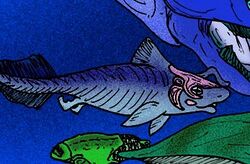Biology:Ptyctodus
| Ptyctodus | |
|---|---|

| |
| Ptyctodus | |
| Scientific classification | |
| Domain: | Eukaryota |
| Kingdom: | Animalia |
| Phylum: | Chordata |
| Class: | †Placodermi |
| Order: | †Ptyctodontida |
| Family: | †Ptyctodontidae |
| Genus: | †Ptyctodus Pander, 1858 |
| Species | |
|
Ptyctodus bradyi | |
Ptyctodus is an extinct armour-plated fish of the late Devonian.[1] Ptyctodus belongs to the family Ptyctodontidae and is of the class Placodermi. They share a close resemblance to modern day chimaeras (Holocephali). Fossils of this armour-plated fish have been found in locations such as in Russia, the Michigan Basis,[2] and Arizona, United States.[3]
Description and paleobiology
Ptyctodus species come in a variety of different sizes, measured data shows three specimens being 94 millimeters, 24 millimeters, 22 millimeters in length, 23 millimeters, 6 millimeters, 4 millimeter in height, and 18 millimeters, 7 millimeters, and 4 millimeters in thickness.[4] Through time, an evolutionary morphological trait is that the species within Ptyctodontidae reduce the dermal armour.[5] The dentition of the Ptyctodus has dental elements that are very similarly observed in chimaeroids.[6] Its dental plates are compressed into a thin cutting edge behind the symphysis and measure 3 inches in thickness and several inches in length.[6] The tritors are expressed as fine punctae in parallel rows.[4] Ptyctodus teeth are very close together in a way that they are like a fish tooth conglomerate.[7] They were also armed with dorsal fin spines closely seen in Hetercanthus and Phlyctaenacanthus.[6] Just like the other members of the family of Ptyctodontidae, there is a sexual dimorphism between the genders of Ptyctodus in the pelvic region where the characteristics are different; males had claspers, while females had large scale like pelvic fins along with their endoskeleton.[8]
Ptyctodus lived in a nektonic carnivore type-ecology and in carbonate, lagoonal, and shallow subtidal environments.[1] Due to structure and shape of the teeth Ptyctodus would easily be able to crush shellfish like organisms at the bottom of the ocean floors, feeding mainly off of that. They also must seem to have been very agile swimmers, able to escape predators, like arthrodires.[2][failed verification]
Species
Species of the Ptyctodus:
- Ptyctodus bradyi was discovered by the basis of two tooth plates in 1942 by Hussakof on Mt. Elden in Arizona.[3]
- Ptyctodus calceolus
- Ptyctodus compressus first documentation was in 1870[4]
- Ptyctodus ferox
- Ptyctodus molaris
- Ptyctodus panderi
Timeline
Timeline of Ptyctodus along with other species within the Ptyctodontidae family <timeline> ImageSize = width:1000px height:auto barincrement:15px PlotArea = left:10px bottom:50px top:10px right:10px
Period = from:-416 till:-299 TimeAxis = orientation:horizontal ScaleMajor = unit:year increment:25 start:-416 ScaleMinor = unit:year increment:5 start:-416 TimeAxis = orientation:hor AlignBars = justify
Colors =
#legends id:CAR value:claret id:ANK value:rgb(0.4,0.3,0.196) id:HER value:teal id:HAD value:green id:OMN value:blue id:black value:black id:white value:white id:paleozoic value:rgb(0.6,0.75,0.55) id:cambrian value:rgb(0.49,0.63,0.33) id:ordovician value:rgb(0,0.57,0.44) id:silurian value:rgb(0.70,0.88,0.71) id:devonian value:rgb(0.8,0.55,0.22) id:earlydevonian value:rgb(0.90,0.71,0.43) id:middledevonian value:rgb(0.96,0.81,0.51) id:latedevonian value:rgb(0.96,0.89,0.71) id:carboniferous value:rgb(0.4,0.65,0.6) id:mississippian value:rgb(0.4,0.56,0.4) id:pennsylvanian value:rgb(0.8,0.77,0.53) id:permian value:rgb(0.94,0.25,0.24) id:mesozoic value:rgb(0.38,0.77,0.79) id:triassic value:rgb(0.51,0.17,0.57) id:jurassic value:rgb(0.2,0.7,0.79) id:cretaceous value:rgb(0.5,0.78,0.31) id:cenozoic value:rgb(0.95,0.98,0.11) id:paleogene value:rgb(0.99,0.6,0.32) id:neogene value:rgb(0.999999,0.9,0.1) id:quaternary value:rgb(0.98,0.98,0.50)
BarData=
bar:eratop bar:space bar:periodtop bar:space bar:NAM1 bar:NAM2 bar:NAM3 bar:NAM4 bar:NAM5 bar:NAM6 bar:NAM7 bar:NAM8 bar:NAM9 bar:NAM10 bar:NAM11 bar:NAM12
bar:space bar:period bar:space bar:era
PlotData=
align:center textcolor:black fontsize:M mark:(line,black) width:25 shift:(7,-4) bar:periodtop from: -416 till: -411.2 color:earlydevonian text:Loch. from: -411.2 till: -407 color:earlydevonian text:Prag. from: -407 till: -397.5 color:earlydevonian text:Ems. from: -397.5 till: -391.8 color:middledevonian text:Eif. from: -391.8 till: -385.3 color:middledevonian text:Givetian from: -385.3 till: -374.5 color:latedevonian text:Frasnian from: -374.5 till: -359.2 color:latedevonian text:Famennian
bar:eratop from: -416 till: -359.2 color:devonian text:Devonian
PlotData=
align:left fontsize:M mark:(line,white) width:5 anchor:till align:left
color:earlydevonian bar:NAM1 from: -411.2 till: -407 text: Tollodus color:middledevonian bar:NAM2 from: -397.5 till: -391.8 text: Goniosteus color:middledevonian bar:NAM3 from: -397.5 till: -385.3 text: Desmoporella color:middledevonian bar:NAM4 from: -397.5 till: -378.1 text: Campbellodus color:middledevonian bar:NAM5 from: -397.5 till: -374.5 text: Ctenurella color:middledevonian bar:NAM6 from: -397.5 till: -359.2 text: Denisonodus color:middledevonian bar:NAM7 from: -397.5 till: -359.2 text: Ptyctodopsis color:latedevonian bar:NAM8 from: -385.3 till: -381.7 text: Chelyophorus color:latedevonian bar:NAM9 from: -385.3 till: -381.7 text: Eczematolepis color:latedevonian bar:NAM10 from: -385.3 till: -381.7 text: Palaeomylus color:latedevonian bar:NAM11 from: -385.3 till: -381.7 text: Ptyctodus color:latedevonian bar:NAM12 from: -385.3 till: -359.2 text: Rhynchodus
PlotData=
align:center textcolor:black fontsize:M mark:(line,black) width:25 bar:period from: -416 till: -411.2 color:earlydevonian text:Loch. from: -411.2 till: -407 color:earlydevonian text:Prag. from: -407 till: -397.5 color:earlydevonian text:Ems. from: -397.5 till: -391.8 color:middledevonian text:Eif. from: -391.8 till: -385.3 color:middledevonian text:Givetian from: -385.3 till: -374.5 color:latedevonian text:Frasnian from: -374.5 till: -359.2 color:latedevonian text:Famennian
bar:era from: -416 till: -359.2 color:devonian text:Devonian
</timeline>
Gallery
References
- ↑ 1.0 1.1 "Ptyctodus Pander 1858". Gateway to the Paleobiology Database. http://www.fossilworks.org/cgi-bin/bridge.pl?a=taxonInfo&taxon_no=34272.
- ↑ 2.0 2.1 Holman, Alan (1995). Life of the Great Lakes Basin: Precambrian to Pleistocene. University of Michigan Press. p. 153.
- ↑ 3.0 3.1 Johnson, Heidemarie; Elliot, David (November 1996). "A New Ptyctodont (Placodermi) from the Upper Devonian Martin Formation of Northern Arizona, and an Analysis of Ptyctodont Phylogeny". Journal of Paleontology 70 (6): 994–1003. doi:10.1017/S0022336000038695.
- ↑ 4.0 4.1 4.2 Branson, E (1922). "The Devonian of Missouri". Missouri Bureau of Geology and Mines 17 (2): 127–128.
- ↑ Trinajstic, Kate; Long, John (2009). A new genus and species of Ptyctodont (Placodermi) from the Late Devonian Gneudna Formation, Western Australia, and an analysis of Ptyctodont phylogeny. 146. pp. 743–760.
- ↑ 6.0 6.1 6.2 Eastman, Charles. "DEVONIAN FISHES OF IOWA". Iowa Geological Survey: 133.
- ↑ Calvin, Samuel; Leonard, A (1897). "Iowa Geological Survey". Annual Report 7: 75.
- ↑ Miles, Roger (October 1967). "Observations on the ptyctodont fish, Rhamphodopsis Watson". Zoological Journal of the Linnean Society 47 (311): 99–120. doi:10.1111/j.1096-3642.1967.tb01398.x.
Wikidata ☰ Q30593733 entry
 |


